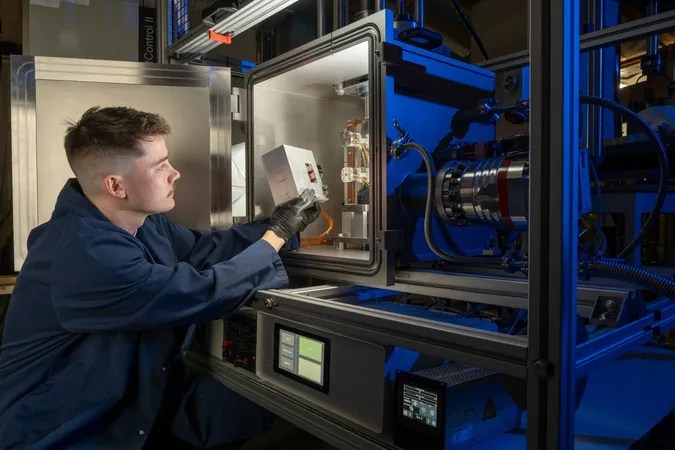
Pioneering 3D Printing Revolutionizes Space Manufacturing at University of Glasgow
2025-05-14
Author: Benjamin
Breakthrough for 3D Printing in Orbit
The University of Glasgow has unveiled a groundbreaking facility aimed at transforming the future of space manufacturing. Enter the NextSpace Testrig—an innovative test site designed specifically for materials destined to be 3D printed in outer space.
A Game Changer for Space Infrastructure
As both space agencies and private enterprises shift towards constructing infrastructure in orbit, testing materials under authentic space conditions is crucial. The NextSpace Testrig bridges the gap between revolutionary ideas and practical applications, enabling rigorous validation for 3D-printed materials.
Financed with a substantial £253,000 grant from the UK Space Agency’s Enabling Technology Programme, the project is spearheaded by Dr. Gilles Bailet along with The Manufacturing Technology Centre.
The Future is 3D Printed
Dr. Bailet notes, "3D printing enables us to create intricate structures directly in space, negating the need for transportation via rockets. This could lead to a plethora of devices being built in orbit—everything from lightweight antennas to components for spacecraft or lunar habitats!"
Why Reimagine Space Manufacturing?
Typically, space missions depend on launching already assembled equipment, which is not only costly but also limited by the size of rockets. Space manufacturing proposes an innovative solution, allowing specialized 3D printers to fabricate complex parts like solar reflectors and spacecraft components directly in orbit.
This revolutionary method promises significant cost savings and logistical advantages, potentially allowing future journeys to assemble structures on the Moon or Mars without the burden of transporting them from Earth.
Addressing the Space Junk Crisis
However, with advancement comes risk. One major concern in in-space 3D printing is structural failure. Tiny imperfections, such as air bubbles or weak layers, could lead to catastrophic failures, sending debris flying at speeds comparable to bullets—dangers that threaten satellites and space stations alike.
The NextSpace Testrig aims to tackle the pressing issue of orbital debris, offering reliable, real-world testing data on the behavior of 3D-printed materials in space-like conditions—information crucial for manufacturers and regulators alike.
Creating a Space Environment on Earth
At its core, the NextSpace Testrig features a specially designed vacuum chamber that mimics the extreme temperatures of space, fluctuating between -150°C and +250°C. This simulation allows researchers to examine how various 3D-printed materials perform under the intense physical stress of orbit.
Unique to this facility is an automated testing system capable of evaluating multiple samples simultaneously, applying forces equivalent to 2,000 kilograms to monitor for any signs of failure.
Positioning the UK as a Leader in Space Tech
The unveiling of the NextSpace Testrig marks a strategic leap for the UK’s burgeoning space sector. Glasgow is already a significant player in satellite manufacturing—producing more satellites than any city outside of California. This state-of-the-art testing facility cements the city's place as a premier hub for space technology.
Dr. Bailet has even developed a prototype 3D printer for orbital use that has been tested in parabolic research flights, paving the way for future missions where spacecraft components could be assembled in orbit, lessening the reliance on costly Earth launches.
Open for Collaboration
Now available for use by academic researchers and commercial partners worldwide, the NextSpace Testrig provides a unique capability that is currently unmatched anywhere else.
By pushing the boundaries of space manufacturing, this visionary initiative from Glasgow not only furthers scientific exploration but also safeguards the future of our space environment.









 Brasil (PT)
Brasil (PT)
 Canada (EN)
Canada (EN)
 Chile (ES)
Chile (ES)
 Česko (CS)
Česko (CS)
 대한민국 (KO)
대한민국 (KO)
 España (ES)
España (ES)
 France (FR)
France (FR)
 Hong Kong (EN)
Hong Kong (EN)
 Italia (IT)
Italia (IT)
 日本 (JA)
日本 (JA)
 Magyarország (HU)
Magyarország (HU)
 Norge (NO)
Norge (NO)
 Polska (PL)
Polska (PL)
 Schweiz (DE)
Schweiz (DE)
 Singapore (EN)
Singapore (EN)
 Sverige (SV)
Sverige (SV)
 Suomi (FI)
Suomi (FI)
 Türkiye (TR)
Türkiye (TR)
 الإمارات العربية المتحدة (AR)
الإمارات العربية المتحدة (AR)